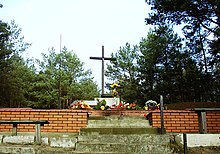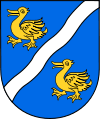Morzewo, Greater Poland Voivodeship
Morzewo [mɔˈʐɛvɔ] (German: Obendorf)[1] is a village in the administrative district of Gmina Kaczory, within Piła County, Greater Poland Voivodeship, in west-central Poland.[2] It lies approximately 2 kilometres (1 mi) south of Kaczory, 13 km (8 mi) south-east of Piła, and 76 km (47 mi) north of the regional capital Poznań.
Morzewo | |
|---|---|
Village | |
.jpg) Church of the Transfiguration in Morzewo | |
 Morzewo  Morzewo | |
| Coordinates: 53°5′0″N 16°53′34″E | |
| Country | |
| Voivodeship | Greater Poland |
| County | Piła |
| Gmina | Kaczory |
| Population | 620 |
| Time zone | UTC+1 (CET) |
| • Summer (DST) | UTC+2 (CEST) |
The village has a population of 620.
History

Morzewo was a private village of Polish nobility, administratively located in the Nakło County in the Kalisz Voivodeship in the Greater Poland Province of the Polish Crown.[3]
During the German occupation of Poland (World War II), the German police carried out a massacre of 41 Poles in the village as part of the Intelligenzaktion.[4] Among the victims were teachers, school principals, priests, policemen, local officials including mayor of the nearby town of Chodzież, merchants, craftsmen, farmers and former insurgents of the Greater Poland uprising from various nearby towns and villages.[4] In November 1940, several Polish families were expelled from Morzewo to the General Government, and some were deported to forced labour to Germany, while their farms were handed over to German colonists in accordance to the Lebensraum policy.[5]
The main sights of Morzewo are the historic church of the Transfiguration and the memorial at the site of the 1939 massacre.
References
- "Former Territory of Germany" (in German). 2017-11-07.
- "Central Statistical Office (GUS) - TERYT (National Register of Territorial Land Apportionment Journal)" (in Polish). 2008-06-01.
- Atlas historyczny Polski. Wielkopolska w drugiej połowie XVI wieku. Część I. Mapy, plany, Instytut Historii Polskiej Akademii Nauk, Warszawa, 2017, p. 1b (in Polish)
- Maria Wardzyńska, Był rok 1939. Operacja niemieckiej policji bezpieczeństwa w Polsce. Intelligenzaktion, IPN, Warszawa, 2009, p. 200 (in Polish)
- Maria Wardzyńska, Wysiedlenia ludności polskiej z okupowanych ziem polskich włączonych do III Rzeszy w latach 1939-1945, IPN, Warszawa, 2017, p. 201 (in Polish)
